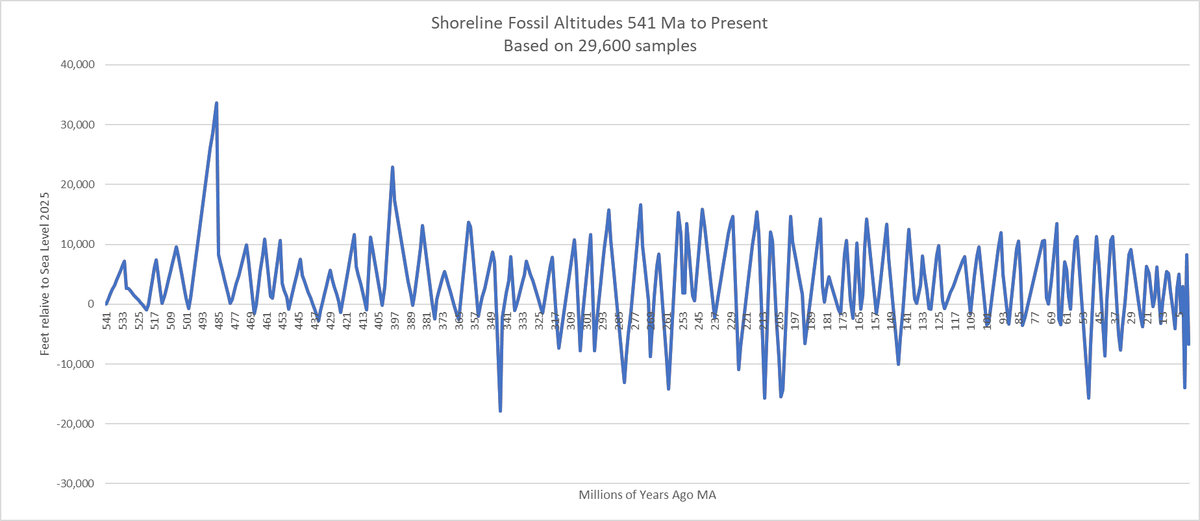[GUEST ACCESS MODE: Data is scrambled or limited to provide examples. Make requests using your API key to unlock full data. Check https://lunarcrush.ai/auth for authentication information.]  James Harris [@WormsofWrath](/creator/twitter/WormsofWrath) on x 1130 followers Created: 2025-07-20 17:30:00 UTC I wish I could express my thoughts on that in two sentences. Like... Sea levels change. A lot. Life hasn't changed much. Starting there, suppose you witness a coral reef where the sea recedes 1mm per year for X million years. The creatures that dwell there changes over time, starting at, say -XX feet, in this order, roughly: sponges, corals, arthropods, salt fish, bivalves, water plants.... X feet: fresh-water fish, water plants, small plants, salamanders, crocodiles, turtles, birds, small mammals, reptiles. 50-600 feet: most of that stuff + tree leaves, other birds. Few other fossils because forests destroy them. 1500 feet: grasslands: Grasses, rhinos, deer, elephants, land birds. And if you had fossils from every stage, viola, there's the whole story of evolution... but they all exist right now. Breeding aka natural selection gets different sizes and significantly different shapes but never puts bananas on seaweed. That requires full-on genetic manipulation which we understand and practice now. Darwin didn't know. Long and short of it: I do not ascribe to creationism or new universe/big bang theory. Objection to life from the ocean: Less than XXX% of life on Earth is in the ocean. It is a carbon-poor, mineral-poor, oxygen-poor environment not conducive to much life. The 'beginning of life' theory is entirely incompatible with that poor environment. Antiquity of fossils: Fossils go extinct. The churning of the Earth, volcanoes, erosion, weather, and life destroys fossils. Thus the smallest fossils are last ones destroyed, hence, the fossil evidence agreement to the theory of life from single-celled organisms. Here is my analysis of sea levels based on fossil evidence, all at the ages declared by the publications of the authors. The average rate of change is 1.009mm per year, roughly half the present rate; maximum 12mm/year. This research greatly contributed to my opinion that life hasn't changed much. This goes a long way to explaining environmental destruction, repetitive species redistribution, and more. Here, also, is a depiction of the Turkey-saurus Rex and what it was found among.  XX engagements  **Related Topics** [coral](/topic/coral) [Post Link](https://x.com/WormsofWrath/status/1946985958617804866)
[GUEST ACCESS MODE: Data is scrambled or limited to provide examples. Make requests using your API key to unlock full data. Check https://lunarcrush.ai/auth for authentication information.]
 James Harris @WormsofWrath on x 1130 followers
Created: 2025-07-20 17:30:00 UTC
James Harris @WormsofWrath on x 1130 followers
Created: 2025-07-20 17:30:00 UTC
I wish I could express my thoughts on that in two sentences. Like... Sea levels change. A lot. Life hasn't changed much.
Starting there, suppose you witness a coral reef where the sea recedes 1mm per year for X million years.
The creatures that dwell there changes over time, starting at, say -XX feet, in this order, roughly: sponges, corals, arthropods, salt fish, bivalves, water plants.... X feet: fresh-water fish, water plants, small plants, salamanders, crocodiles, turtles, birds, small mammals, reptiles. 50-600 feet: most of that stuff + tree leaves, other birds. Few other fossils because forests destroy them. 1500 feet: grasslands: Grasses, rhinos, deer, elephants, land birds. And if you had fossils from every stage, viola, there's the whole story of evolution... but they all exist right now.
Breeding aka natural selection gets different sizes and significantly different shapes but never puts bananas on seaweed. That requires full-on genetic manipulation which we understand and practice now. Darwin didn't know.
Long and short of it: I do not ascribe to creationism or new universe/big bang theory.
Objection to life from the ocean: Less than XXX% of life on Earth is in the ocean. It is a carbon-poor, mineral-poor, oxygen-poor environment not conducive to much life. The 'beginning of life' theory is entirely incompatible with that poor environment.
Antiquity of fossils: Fossils go extinct. The churning of the Earth, volcanoes, erosion, weather, and life destroys fossils. Thus the smallest fossils are last ones destroyed, hence, the fossil evidence agreement to the theory of life from single-celled organisms.
Here is my analysis of sea levels based on fossil evidence, all at the ages declared by the publications of the authors. The average rate of change is 1.009mm per year, roughly half the present rate; maximum 12mm/year.
This research greatly contributed to my opinion that life hasn't changed much. This goes a long way to explaining environmental destruction, repetitive species redistribution, and more.
Here, also, is a depiction of the Turkey-saurus Rex and what it was found among.

XX engagements
Related Topics coral